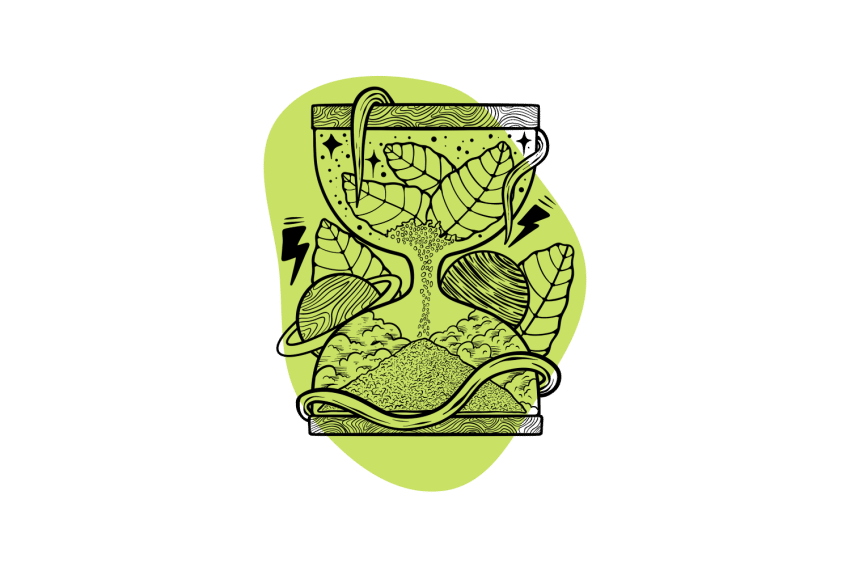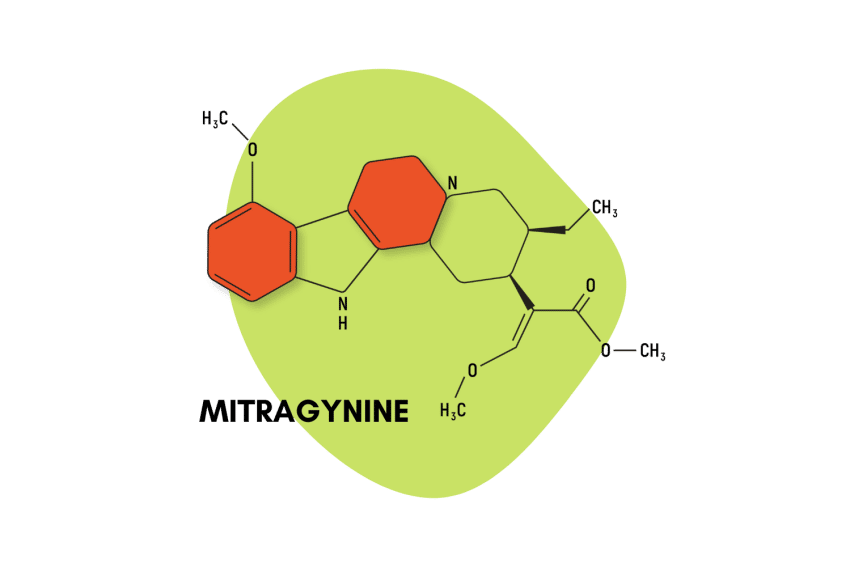How Long Does Kratom Stay in the System?

Like many other substances, kratom (Mitragyna speciosa) can be detected in your system even after its effects have worn off.
Mitragynine, one of kratom’s major pharmacologically active compounds, stays in your blood for up to 14 days and in your hair and nails for about six months.
Most ingredients in kratom are eliminated from the body in a short time if you only use the herb occasionally. However, if you take kratom daily, it will take longer to get rid of it completely.
This article will inform you about how long kratom stays in the system and the factors that affect its metabolism and process of elimination. We’ll also talk about drug tests and how likely it is for kratom to make you fail one.
Understanding Kratom’s Half-Life & Detection
In biology, the term “half-life” refers to the time it takes for an individual to get rid of half the amount of a substance ingested. It takes roughly 6 or 7 half-lives to eliminate a substance from the bloodstream entirely.
Most drug tests don’t test for kratom, and those that do, mainly test for mitragynine and 7-hydroxymitragynine [1]. Some more specialized tests additionally check for alkaloids paynantheine and speciociliatine, alongside mitragynine’s diastereomer speciogynine.
Mitragynine’s half-life is 24 hours [2]. A dose of 5 grams of kratom powder contains roughly 90 mg of mitragynine — which means it would take roughly 7–10 days to clear from the body enough to pass drug test detection limits.
7-hydroxymitragynine has a half-life of around 3.6 hours [3]. A dose of 5 grams of kratom powder contains roughly 2 mg of 7-OH-mitragynine — which means it would take roughly 24 hours for this alkaloid to be cleared from the bloodstream entirely.
However, other alkaloids are also present in the plant; each remains in the body for different periods. For example, the alkaloid speciociliatine has a shorter half-life of just 15 hours; others, such as speciogynine and paynantheine, have a longer half-life of approximately 40 hours.
These alkaloids are present in very low concentrations and are likely cleared from the body much sooner than mitragynine, which makes up the bulk of kratom’s alkaloid profile.
This means you’ll likely probably be fine if you avoid kratom for seven days before a drug test. Still, to be even safer, avoid kratom for 14 days before a test.
It’s important to note that half-life also depends on age, sex, weight, body fat, how often you take kratom, other medications or supplements, nutrition, and hydration, among other factors.

Will Kratom Be Detected in a Drug Test?
Although kratom can be theoretically detected in classic drug tests for around seven days after ingestion, it’s unlikely to cause users to fail a drug test for one simple reason — nobody is looking for it.
Kratom is not illegal in most parts of the world and is, therefore, not included in most drug tests. A drug test will only find what it’s looking for, so if kratom alkaloids aren’t included on this list, they’re not going to show up.
Some worry kratom will produce a false positive for opiates because the active ingredients also work through the opiate system. However, this is not the case. Kratom’s alkaloids may interact with the opioid system to varying degrees, but they don’t look like opiates and won’t register as opiates on a drug test.
Some tests may be able to pick up kratom use beyond 7 days. For example, mitragynine can be detected by trapping biomarkers in the keratin fibers as you grow nails and hair. This non-intrusive method can detect kratom for up to 3 months in hair and 3-6 months in nails.
Estimated detection windows for kratom:
- Saliva Test: Up to 24 hours
- Blood Test: Up to 14 days
- Urine Test: Up to 7 days
- Hair Test: Up to 3 months
- Nail Test: Up to 6 months

How To Eliminate Kratom From the Body Faster
Suppose you took kratom yesterday and found out you’ll be taking a drug test tomorrow. Assuming the test looks for kratom use, there’s little you can do to prevent kratom from showing up beside taking measures to accelerate your metabolism and hoping for the best.
The following are ways to help your system quicken the elimination of kratom safely. Still, these will not guarantee a successful drug test.
1. Increase Your Intake of Food & Water
The first way is to incorporate more food into your diet, especially protein-based food. The thermic food effect, also known as TEF, accelerates your metabolism by augmenting the energy required for digestion if you ingest more protein [4].
You can also try drinking more water than usual. Research has shown that drinking 500 mL of water will increase metabolism when resting by 30% for an hour [5].
But be sure not to overdo it — an excess water intake can lead to water poisoning.

2. Exercise Regularly
Another way to accelerate your metabolism is by doing high-intensity interval training, also known as HIIT. This exercise will make you burn more fat even after working out [6]. You can fill up your quota by running or biking.
This is important because mitragynine, and many other alkaloids present in kratom, are lipophilic [7]. This means they can dissolve into your fat stores and leak back into the bloodstream later. This could cause you to fail a drug test long after the 14-day “maximum” we mentioned before.
The chances of this happening are slim but not impossible. It becomes more likely in those with high body fat. Risk further increases if you’re actively losing weight just before the drug test. As fat breaks down, kratom alkaloids are freed from their fat reserves.
You may also find success by trying anaerobic exercises to build more muscle. Research has shown that muscle is more metabolically active than fat. Visiting the gym might be a good idea to accelerate your metabolism to clear kratom more quickly.

3. Ingest Green Tea & Caffeine
Studies suggest green tea is beneficial when trying to lose weight [8]. This tea has been shown to increase the fat you burn while exercising. It has also been shown to increase metabolism and fat burning even if you don’t do so.
The final way is to ingest plenty of caffeine. Caffeine from green tea and coffee has been shown to boost metabolism and help burn excess fat [9].

Kratom Dosage & Effects
Two key factors affect how much kratom you should take and why.
First and foremost, you should decide on which effects you’re looking for. Do you want the energizing qualities or the sedative/analgesic effects?
Next, you should measure your body weight and have an estimate of your tolerance.
Typical doses and effects of kratom:
- Low doses (2-4 grams): Subtle stimulant effects, recommended for beginners
- Moderate doses (4-6 grams): Euphoric & calming, recommended for most users
- High doses (6-12 grams): Powerful sedating and painkilling action
You should start feeling the effects of kratom after 20 to 30 minutes. You’ll likely reach the peak at about 1 to 2 hours. After about 8 hours, the effects should have completely worn off.
We suggest you space your doses by 1-2 days to prevent your system from developing tolerance toward kratom. If you are a beginner, remember to take small amounts initially, gradually increasing them over time and as you see fit.

Kratom Side Effects
Although people who take kratom believe in its worth, it can have side effects. They vary in intensity and frequency depending on the dosage and history of usage you might have had.
Kratom’s side effects include:
- Dizziness
- Drowsiness
- Dry mouth
- Headaches
- Heart palpitations
- Nausea
- Poor muscle coordination
- Weight loss
In extreme cases, kratom can lead to:
- Dependence & addiction
- Depression
- Hallucinations
- Liver damage
Keep in mind that most of these side effects — particularly the ones happening in extreme cases — result from misusing kratom and taking much more than you should have.

Conclusion: How Long Does Kratom Stay in the System?
Kratom stays in the bloodstream for a minimum of 14 days and up to six months in the hair and nails.
However, it’s very unlikely to be detectable after just seven days. Avoid kratom for at least 2 weeks before a drug test to play it safe.
If you need to rid your body of kratom as soon as possible, you can try accelerating your metabolism with supplements, water, and exercise. However, this won’t guarantee a successful test.
Still, kratom is unlikely to be detected in a standard drug test, as it’s legal in the US and most parts of the world. It makes little sense for organizations in these countries to check for kratom on a standard 12-panel drug test.
References
- Le, D., Goggin, M. M., & Janis, G. C. (2012). Analysis of mitragynine and metabolites in human urine for detecting the use of the psychoactive plant kratom. Journal of analytical toxicology, 36(9), 616-625.
- Tanna, R. S., Nguyen, J. T., Hadi, D. L., Manwill, P. K., Flores-Bocanegra, L., Layton, M. E., … & Paine, M. F. (2022). Clinical pharmacokinetic assessment of kratom (Mitragyna speciosa), a botanical product with opioid-like effects, in healthy adult participants. Pharmaceutics, 14(3), 620.
- Maxwell, E. A., King, T. I., Kamble, S. H., Raju, K. S. R., Berthold, E. C., León, F., … & Sharma, A. (2021). Oral pharmacokinetics in beagle dogs of the mitragynine metabolite, 7-hydroxymitragynine. European journal of drug metabolism and pharmacokinetics, 46(3), 459-463.
- Leidy, H. J., Clifton, P. M., Astrup, A., Wycherley, T. P., Westerterp-Plantenga, M. S., Luscombe-Marsh, N. D., … & Mattes, R. D. (2015). The role of protein in weight loss and maintenance. The American journal of clinical nutrition, 101(6), 1320S-1329S.
- Vij, V. A., & Joshi, A. S. (2013). Effect of ‘water induced thermogenesis’ on body weight, body mass index and body composition of overweight subjects. Journal of clinical and diagnostic research: JCDR, 7(9), 1894.
- Matos, M. A. D., Vieira, D. V., Pinhal, K. C., Lopes, J. F., Dias-Peixoto, M. F., Pauli, J. R., … & Amorim, F. T. (2018). High-intensity interval training improves markers of oxidative metabolism in skeletal muscle of individuals with obesity and insulin resistance. Frontiers in Physiology, 9, 1451.
- Ramanathan, S., Parthasarathy, S., Murugaiyah, V., Magosso, E., Tan, S. C., & Mansor, S. M. (2015). Understanding the physicochemical properties of mitragynine, a principal alkaloid of Mitragyna speciosa, for preclinical evaluation. Molecules, 20(3), 4915-4927.
- Ota, N., Soga, S., Shimotoyodome, A., Haramizu, S., Inaba, M., Murase, T., & Tokimitsu, I. (2005). Effects of combination of regular exercise and tea catechins intake on energy expenditure in humans. Journal of Health Science, 51(2), 233-236.
- Harpaz, E., Tamir, S., Weinstein, A., & Weinstein, Y. (2017). The effect of caffeine on energy balance. Journal of basic and clinical physiology and pharmacology, 28(1), 1-10.









